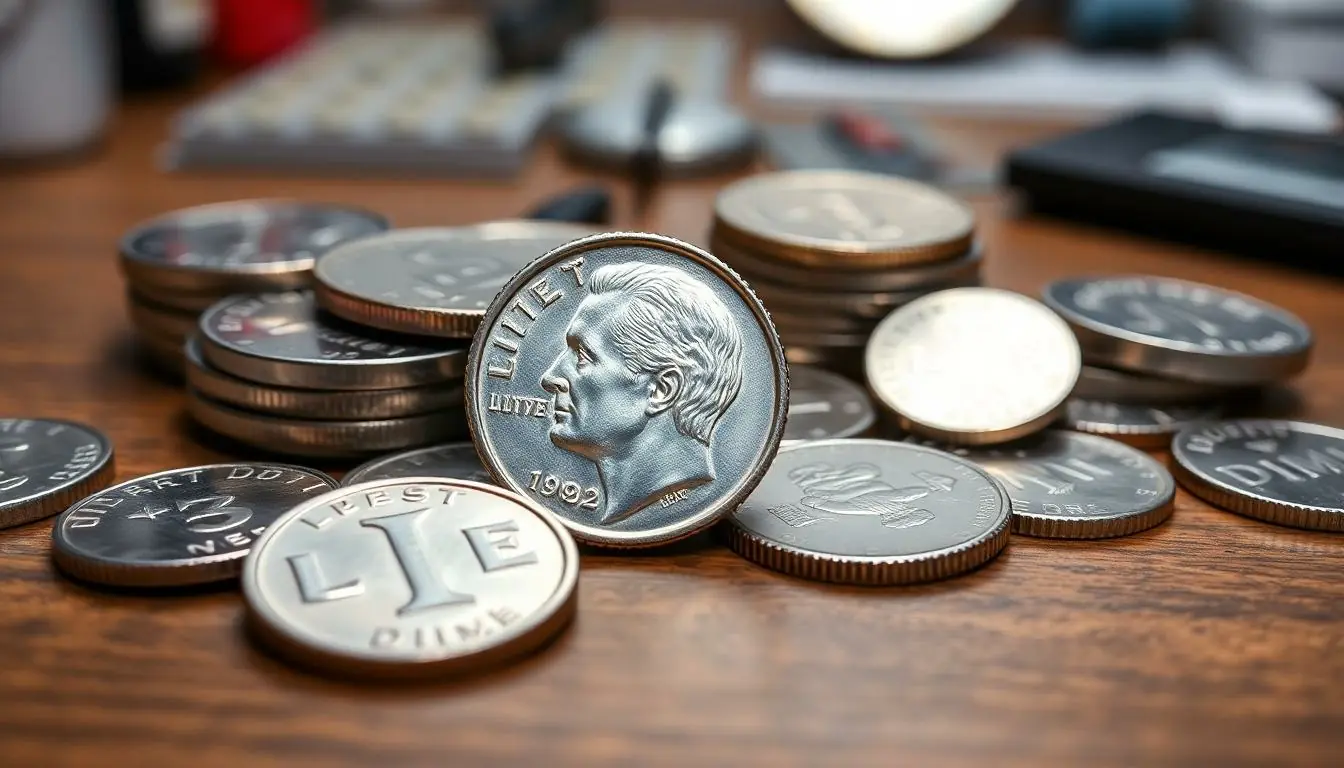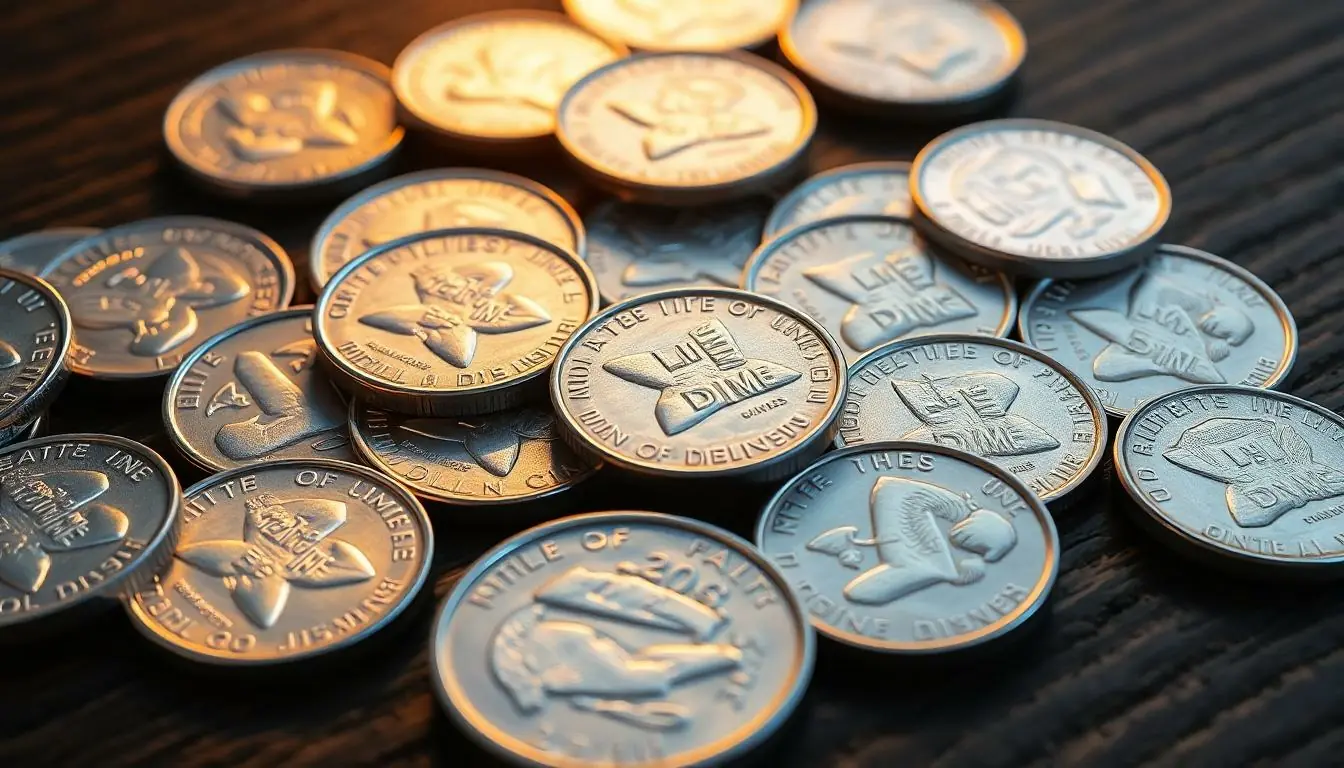In a world where pennies seem to be more trouble than they’re worth, dimes are quietly stealing the spotlight. Who knew that those tiny silver coins could pack such a punch? While most folks toss them into jars or let them languish in the couch cushions, some modern dimes are actually worth a small fortune. Yes, you read that right—your pocket change could be hiding a treasure!
Table of Contents
ToggleUnderstanding Modern Dimes Worth Money
Modern dimes can hold unexpected value beyond their face value. Collectors and numismatists often search for specific varieties or errors that increase the worth of these coins. Examples include the 1982 and 1983 dimes, which may contain unique mint mark variations, making them desirable.
Varieties such as the 2001 dimes with no mint mark or the 1996 dimes featuring a “W” for West Point are also noteworthy. Significant demand exists for these coins, driving prices higher in the collector market. The current value of a coin often depends on its condition, with uncirculated examples fetching premium prices.
Error coins stand out in the market as well. The 1982 dimes, exhibiting a small lettering variety, have attracted interest due to their scarcity. Collectors can pay up to $50 or more for these specific coins, highlighting the importance of careful examination.
Additional factors affecting a dime’s value include the historical context and the metal composition. Coins minted before 1965 contain silver, contributing to their higher market value compared to modern copper-nickel dimes. These earlier coins draw significant interest, as the current silver prices provide a tangible benefit for collectors.
The market for modern dimes worth money continuously evolves, influenced by trends and collector interests. Regularly tracking auctions or visiting numismatic shows can reveal current market prices. Understanding these elements enables better decision-making when it comes to collecting or trading dimes.
Key Factors That Determine Value

Several key factors influence the value of modern dimes. These include minting errors and specific rare dates or varieties.
Minting Errors
Minting errors significantly increase a dime’s value. Errors can arise during production, leading to unique characteristics. For example, the 1982 dime with small lettering stands out among collectors and can fetch prices over $50. Other common errors include off-center strikes or double dies, which create visual anomalies on the coin. These mistakes capture interest and prompt premium pricing due to their rarity. Understanding what errors exist helps collectors identify potential treasures in their collections.
Rare Dates and Varieties
Rare dates and varieties elevate a dime’s market value based on demand. The 1982 and 1983 dimes often command prices due to their specific mint mark variations, which appeal to collectors. Each year, certain mints produce limited numbers, increasing scarcity. Dimes lacking a mint mark, like many from 2001, also attract attention due to their rarity. Collectors search for these distinct features to add value to their collections. Recognizing these rare examples can significantly enhance the worth of an individual’s collection.
Notable Modern Dimes Worth Collecting
Certain modern dimes hold notable value for collectors. Specific years and minting errors stand out for their rarity and demand, offering potential for profit.
1982 No P Mintmark Dime
The 1982 No P Mintmark Dime is a significant find among collectors. Minted without a “P” mark in Philadelphia, this dime often attracts attention due to its distinctiveness. Circulated examples can fetch around $5, while uncirculated specimens can command prices over $100. Collectors value this dime not only for its rarity but also for the unique story surrounding its issuance. As with all coins, the condition drastically influences market value, making well-preserved dimes particularly desirable.
1996-W Roosevelt Dime
The 1996-W Roosevelt Dime was minted exclusively for the Olympic Winter Games, marking its uniqueness. Many collectors seek this dime due to its limited release at just 1.4 million coins. Typical values hover around $10 for circulated examples, with pristine pieces often exceeding $50. Its connection to a historical event adds to its allure and market demand. The combination of historical significance and low mintage creates a compelling reason for collectors to pursue this dime vigorously.
How to Evaluate Your Dimes
Evaluating dimes requires attention to detail and knowledge of grading standards. Collectors focus on specific attributes that affect a coin’s market value.
Grading Standards
Grading modern dimes generally follows the Sheldon scale, which ranges from 1 to 70. This system evaluates features such as strike quality, surface preservation, and overall appearance. Coins in grades of 60 or higher often attract significant interest. Inspect for any signs of wear or damage that may lower the grade. Look for luster and sharpness in details to enhance its appeal. Collectors often prefer uncirculated examples, which can substantially increase value.
Appraisal Tips
Assessing the value of a dime includes several important strategies. First, research recent sales to understand market trends and values. Using reputable numismatic databases enhances accuracy during evaluation. Check for noticeable mint errors, as these can dramatically inflate worth. Examine coin conditions closely; uncirculated pieces command impressive premiums. Joining numismatic communities provides valuable insights and resources. Discuss with experienced collectors for expert opinions on rarities and market flow.
Where to Sell Your Valuable Dimes
Selling valuable dimes can take place through various channels, each offering distinct advantages. Finding the right avenue is crucial for maximizing profits.
Online Platforms
Online platforms provide an accessible way to reach potential buyers. Websites like eBay, Etsy, and specialized coin selling sites connect sellers with collectors. Listing dimes with accurate descriptions and high-quality images increases visibility. Search various completed listings to determine competitive pricing. Auctions can help generate higher bids for sought-after coins. Furthermore, online forums allow sellers to engage with experienced collectors for advice and potential sales. Some platforms also offer seller protection, ensuring secure transactions.
Local Coin Shops
Local coin shops serve as reliable outlets for selling valuable dimes. A knowledgeable staff, typically composed of numismatists, provides immediate appraisals and cash offers. Building rapport with local dealers can lead to beneficial negotiations and a better understanding of market value. Regular visits can reveal insights about current trends and demand in the numismatic community. Attending coin shows hosted by shops often presents opportunities to sell directly to multiple interested buyers. Additionally, local shops may help with consignment sales, allowing sellers to benefit from their established clientele.
Modern dimes hold more value than many realize. With specific varieties and minting errors, these coins can transform everyday pocket change into valuable collectibles. Collectors are increasingly drawn to rare dates and unique characteristics that significantly enhance a dime’s worth.
Understanding the grading system and market trends is essential for anyone looking to buy or sell these coins. By staying informed and exploring various selling platforms, individuals can maximize their profits while enjoying the fascinating world of numismatics. Whether it’s a rare 1982 dime or a unique 1996-W Roosevelt Dime, there’s potential treasure waiting to be discovered in those small coins.







